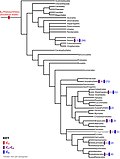Angiosperm Phylogeny Group
The Angiosperm Phylogeny Group (APG) is an informal international group of botanists who came together to get a consensus on the taxonomy of flowering plants (angiosperms). They wanted to base it on plant relationships got from phylogeny. Four versions of a classification system have come from this collaboration. They were published in 1998, 2003, 2009 and 2016. Earlier angiosperm classifications were not based on monophyletic groups (i.e., groups that include all the descendants of a common ancestor).
Principles of the APG system
The principles of the APG's approach to classification were set out in the first paper of 1998, and have remained unchanged in subsequent revisions. Briefly, these are: [1]
- The Linnean system of orders and families should be kept.
- "The family is central in flowering plant systematics". Classifying families in orders is a "reference tool of broad utility". Orders are of particular value in teaching, and in studying family relationships.
- Groups should be monophyletic (i.e. consist of all descendants of a common ancestor).
- The main reason why existing systems are rejected is because they do not have this property. They are not proved to be phylogenetic.
- A limited number of larger orders will be more useful than lots of small orders.
- Above or parallel to the level of orders and families, the term clades is used more freely. Some clades have later been given formal names.[2] The authors say that it is "not possible, nor is it desirable" to name all clades in a phylogenetic tree. However, systematists need to agree on names for some clades, particularly orders and families, for communication and discussion.
Phylogenetic nomenclature
For a detailed discussion on phylogenetic nomenclature, see Cantino et al 2007.[3] The latest version is APG IV.[4]
Angiosperm Phylogeny Group Media
Evolution of the angiosperms according to the Angiosperm Phylogeny Group (2013)*Key: C3 – C3 carbon fixation; C4 – C4 carbon fixation
Reference
- ↑ Group, The Angiosperm Phylogeny (1998). "An Ordinal Classification for the Families of Flowering Plants". Annals of the Missouri Botanical Garden. 85 (4): 531–553. doi:10.2307/2992015. JSTOR 2992015.
- ↑ Chase, Mark W.; Reveal, James L. (2009). "A phylogenetic classification of the land plants to accompany APG III". Botanical Journal of the Linnean Society. 161 (2): 122–127. doi:10.1111/j.1095-8339.2009.01002.x.
- ↑ Cleven, N. Andrew N. (1936). "Reviewed work: Puna de Atacama. Bergfahrten und Jagden in der Cordillere von Südamerika. Mit einer Einführung von Albrecht Penck., Walther Penck; Indianer-Rassen und Vergangene Kulturen. Betrachtungen zur Volksentwicklung auf einer Forschungsreise durch Sud- und Mittelamerika., Richard N. Wegner". The Hispanic American Historical Review. 16 (1): 72–75. doi:10.2307/2506586. JSTOR 2506586.
- ↑ "An update of the Angiosperm Phylogeny Group classification for the orders and families of flowering plants: APG IV". Botanical Journal of the Linnean Society. 181: 1–20. 2016. doi:10.1111/boj.12385. S2CID 7498637.
